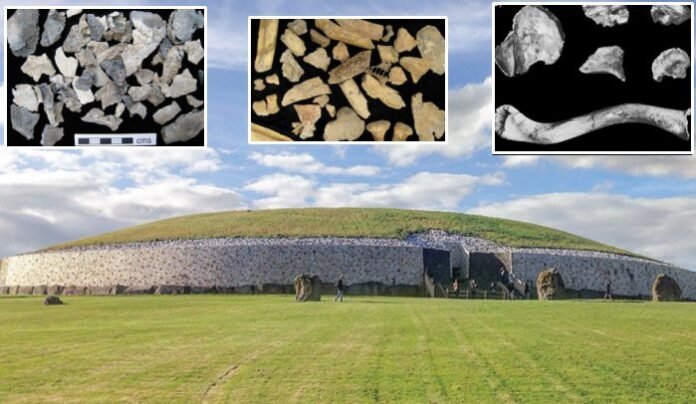Newgrange before, during and after excavation (top: April 1950 © Photographic Archive, National Monuments Service, Government of Ireland; Image source
Researchers studied burials at the Newgrange monument in Ireland, a large mound with a chamber for cremated and unburnt remains. The findings suggest those buried were likely from an elite class or royal family.
In 2020, the DNA analysis of a bone skull fragment discovered in the chamber indicated that at least one individual interred there was the offspring of a relationship between either siblings or a parent and child.
Additionally, it was also distantly related to others buried in the chamber.
It is believed that only select individuals were entombed in this location, suggesting they occupied a ‘special’ status within society. The inference drawn is that if an individual born of incest was placed in the chamber, such practices must have been ‘accepted’ by society, potentially due to their prevalence among a ruling elite.
Image credit: March 1968, Howard Goldbaum (voicesfromthedawn.com); source
Now, researchers from the University of York and University College Dublin have shown that there is a lack of corroborating evidence in nearby settlements, dietary practices, or trade to support the existence of an elite class either economically or socially. This insight leads researchers to reconsider the society’s structure of that era, suggesting it was more egalitarian.
The belief is based on observations that resources were shared and exchanged among individuals who lived in similar types of dwellings.
Professor Penny Bickle, from the Department of Archaeology at the University of York, stated that the evidence indicates a significantly collective ethos. There are no substantial disparities in diet, and the houses are relatively modest and uniform in construction.
The absence of extensive settlement systems or trade mechanisms, and the lack of large-scale craft production as observed in other ancient civilizations like Ancient Egypt—where incest was reportedly practiced by the ruling elite—suggests a different societal structure.
Image credit: Tjp Finn, CC BY-SA 4.0). Image source
“We can only begin to understand these monuments and tombs if we examine the social lives or the communities that built and use them, and when we start to do this, this idea of a ‘social elite’ or a form of royalty starts to appear less likely,” Prof. Bickle added.
Newgrange, a prehistoric monument located in the Boyne Valley, County Meath, is older than both Stonehenge and the Pyramids of Giza. It is believed to have been constructed around 5,000 years ago by a thriving farming community. The site was rediscovered in AD 1699; however, its interior had been significantly disturbed before modern excavations took place in the 1960s. This has led researchers to question whether it was initially intended as the burial site for the skull fragment known as NG10, which has been dated to between 3340 and 3020 BC.
The genetic clustering observed in passage tombs, including those at Newgrange, predominantly indicates distant biological relationships—comparable to second cousins or great-great-great-grandparents—rather than immediate familial connections. Researchers assert that if these tombs were indeed designated for an elite class, one would anticipate much closer genetic ties than those currently identified at Newgrange.
These tombs likely reflect family, work, and social relationships rather than marking an elite family group.
“People were definitely being selected for burial in passage tombs – the whole community does not end up in these monuments. However, we don’t know the reasons behind this selection, and why they were thought to be special.
“Unlike today, bodies don’t tend to be buried ‘whole’ or ‘intact’ in this time period. Before they end up in megalithic monuments, bodies are broken down, sometimes cremated and even circulated around their communities,” commented associate professor Jessica Smyth, from University College Dublin.
Many of the dead in these passage tombs were mixed with cremated remains and possibly moved around, making it unclear if those who placed the NG10 fragment in Newgrange knew the individual’s identity or parents, casting doubt on their ‘special’ status.
“It is by no means clear that the monument was the first burial site of NG10 and the tomb grew in stages, so tracing who this individual was is a very difficult task indeed. As it stands the incestuous origins of NG10 are a one-off compared to all of the DNA data we have for Neolithic Ireland,” Prof. Bickle said.
“There are still many questions to solve here, but building this picture means looking at the monument together with the society that was built up around it, and from this, we get a step closer to understanding a community that was much more inclusive and equal than previously thought.”
Written by Conny Waters – AncientPages.com Staff Writer









